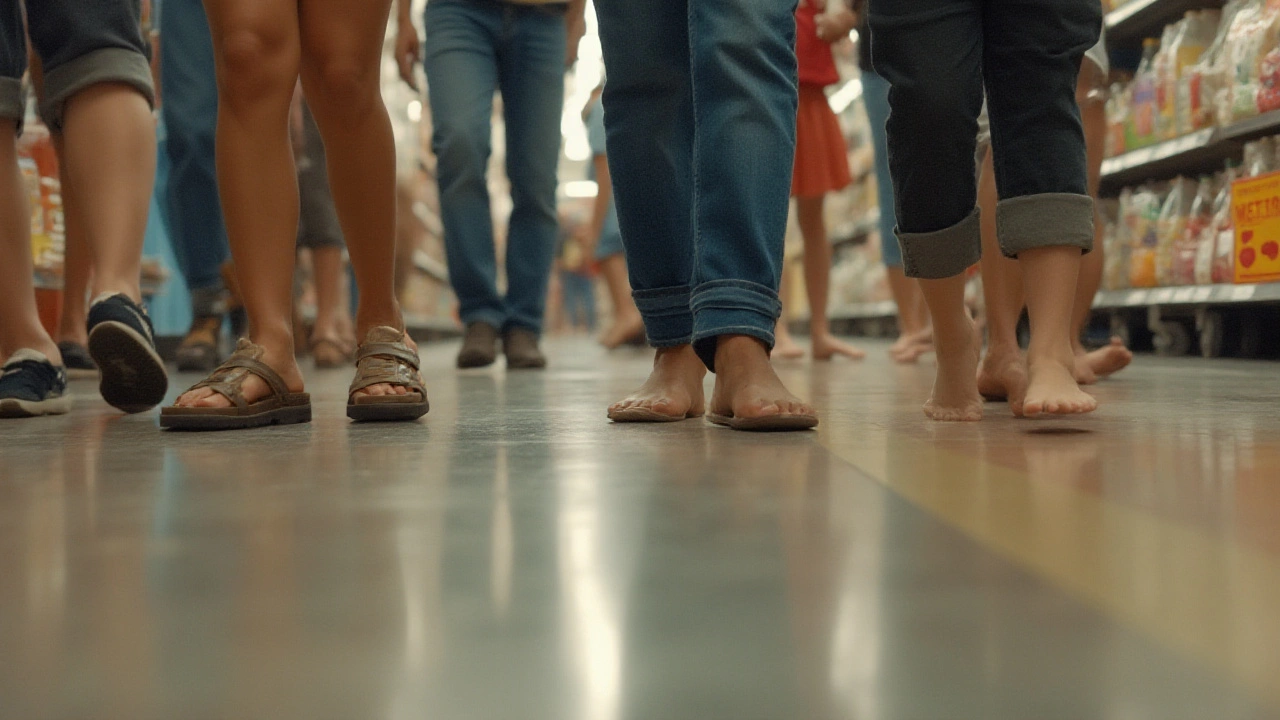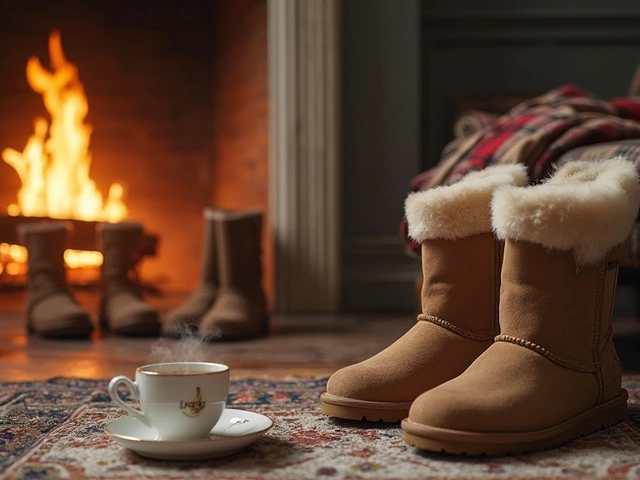Can You Walk Barefoot in Walmart? Rules, Risks & Facts Explained

- Cleo Fairchild
- 2 August 2025
- 0 Comments
Picture walking the vinyl floors of your local Walmart without shoes—just the cool, slick surface on your feet while grabbing eggs and shampoo. It sounds simple, maybe even freeing, but this idea tends to spark a heated debate online and off. For many, the thought of someone shopping barefoot feels rebellious—or downright odd. There’s even a cult-like corner of the internet full of people defending their right to shop sans shoes. But does Walmart actually allow this? Let’s break down the real deal behind barefoot shopping at this retail giant, so you don’t end up in a facepalm-worthy moment with store security.
What Walmart’s Dress Code Really Says
Here’s a myth that refuses to die: somewhere, deep in the rules, Walmart outright bans bare feet. Scour the official website—you won’t find a detailed public dress code laid out for shoppers. But in practice, and according to staff handbooks and employee testimonies posted on forums like Reddit and Glassdoor, the unwritten rule does exist: shoes are expected. The reason? Walmart wants to create a safe, comfortable environment and minimize legal risks. Their so-called dress code typically means shirts and shoes are mandatory, mostly for two reasons: safety (think spilled pickle jars and rogue shopping carts) and liability (avoiding lawsuits if you step on a broken bottle or slip on a berry one aisle over).
But things aren’t black-and-white. Some folks push their luck, especially in small-town Walmarts that operate a bit more informally. Employees sometimes look the other way, especially during late-night hours or in stores with lighter crowds. Of course, that’s not a green light everywhere. Most employees have the right to turn away or ask a barefoot shopper to leave at their discretion, and managers may enforce the rules more strictly in busy locations.
If you’re hoping to rebel, don’t expect anything in writing on the front door. The classic "No shirt, no shoes, no service" sign is not universal at every Walmart, but expect staff to politely point you to it if you strut in bare. During the pandemic, signage about shoe and mask requirements increased, and many stores stuck with them afterward because they make it easy to ask someone to comply. So, even if you find a gap in the rules, you might run right into a store’s policy—and that means putting on shoes or heading back to your car.
Is there a federal or state law that forces you to put on those flip-flops? No. Most states, including Texas, California, and Florida, don’t have laws against barefoot shopping. It’s a business policy, not a legal drama. But don’t get too comfortable—local ordinances or health codes can give stores a reason to set stricter internal rules, especially in places that sell food.
So, the verdict: Officially, Walmart prefers shoppers to wear shoes. Unofficially, you might get away with it, but chances are someone will notice. And when staff asks, you’ll have to comply. The real risk lies more in being embarrassed or turned away than getting fined or arrested.
The Barefoot Dilemma: Health, Safety, and Public Perception
If you’re tempted to go barefoot for comfort, or simply because you forgot your sandals, give a thought to what’s lurking on those high-traffic floors. Walmart stores see up to 37 million visitors each day across the U.S., according to company estimates. Each wave of customers tracks in dirt, bacteria, dropped food, and who knows what else. A 2017 environmental health study found grocery store floors host higher concentrations of staphylococcus, E. coli, and other bacteria than most sidewalks. Grossed out yet?
It’s not just germs. Stores like Walmart deal with lots of glass, sharp packaging ties, and sticky messes—think pickle jars, baby food, soda cans exploding, you name it. Spills get cleaned up, but not instantly. Walking barefoot, you lose any protection against cuts, splinters, or chemical residues from cleaning products. The most common Walmart injuries reported by customers revolve around slips, trips, and falls—and without shoes, your odds only go up. Even small cuts can lead to infections that spiral into bigger health issues, especially for people with diabetes or compromised immune systems.
Now let’s address the elephant in the aisle: how people react. Being barefoot in public is sure to turn heads. Some are fascinated, others put off. Internet forums and barefoot enthusiast blogs tell stories of everything from judgmental stares to outright confrontations. A lot depends on where your Walmart is and how tolerant (or amused) your fellow shoppers tend to be. But one thing’s for certain: you’ll stand out. In some places that could even work in your favor, like in beach towns. But if blending in is your thing, bare feet might not be the best icebreaker.
You might meet people online who swear by barefoot shopping for health reasons. There’s a subculture called "barefooters"—folks who believe going without shoes helps posture, strengthens foot muscles, and connects them to the earth. While there’s merit in many of the arguments for going barefoot outdoors (just look up "earthing"), most podiatrists say public shopping areas aren’t the place. The risk of injury and infection simply outweighs any small wellness benefit—at least when you’re pushing a cart past the frozen peas.

Barefoot in Public: Myths, Facts & Real Stories
A lot of barefoot curious folks cling to certain myths, like the idea that health departments make it illegal, or that corporate policy was inspired by some ancient barefoot-related lawsuit. Actuality? The U.S. Department of Health doesn’t ban barefoot shopping. Food code regulations apply to employees, not customers. That rumor started in the ‘70s and just stuck, like gum on a bare heel.
If you scroll through dedicated barefoot living forums, you’ll find adventure stories from people who’ve walked through countless Walmarts sans shoes. Some report being ignored or even getting compliments. Others say they were quickly stopped by security and told to leave or come back shod. A regular theme pops up: whether you succeed or get kicked out just depends on the mood of the manager and the crowd size. Some stores simply tolerate regular barefoot visitors, especially younger shoppers or those who claim a medical reason. (Though, if you do use a medical excuse, expect more questions over accessibility policy and perhaps requests for documentation.)
There are famous viral moments, including TikToks and YouTube clips, featuring people attempting the barefoot shopping challenge. In 2023, a trend sparked Instagram reels with the hashtag #BarefootWalmartChallenge, but most attempts ended with store staff politely asking influencers to put their shoes back on. Walmart’s official response, when asked by news outlets, is consistent: "Safety of our associates and customers is our top priority. Customers are asked to wear appropriate attire, including footwear, when shopping in our stores." So, while nobody’s coming in with a measuring tape to prove you’re 100% shod, it isn’t exactly a green light.
One area of confusion: service animals vs. barefoot customers. A service dog is protected by ADA guidelines, and nobody’s going to enforce a paw-shoe rule. Customers, though, don’t have that type of right. Even folks with religious or cultural reasons for going barefoot are usually expected to talk to management ahead of time and might need documentation to explain their request. Don’t expect to stroll in and flash a "barefoot rights" card like it’s some kind of magic ticket.
People also ask about kids—are barefoot toddlers treated differently? Store policy usually applies to everyone, but in practice, babies and toddlers being carried or riding in carts don’t attract as much attention. Most staff focus on adult shoppers walking around with bare feet, not restless kids in the shopping cart.
If You Must Go Barefoot: Tips & Alternatives
Still determined to try your luck? There are ways to minimize hassle—and keep your feet safe—in case your shoes break, get soaked, or disappear mysteriously in your car. Here are some shopper-tested tips:
- Plan Ahead: Keep a backup pair of cheap flip-flops or foldable shoes in your car or bag. They’re light, fast to slip on, and can save you awkward run-ins with store staff.
- Ask Management: If you have a legitimate reason to go barefoot—skin issues, medical conditions, or simple curiosity—it never hurts to ask for an exception. Sometimes a friendly chat goes further than you’d think, especially at smaller Walmarts.
- Choose Your Time: Late nights and early mornings usually mean lighter crowds and more relaxed staff. If you’re trying to go unnoticed, this is your best shot.
- Stay Aware: Keep your eyes peeled for spills, dropped glass, and sharp package ties. Be ready to step lightly and dodge trouble spots on the floor.
- Watch for Security Cameras: Large stores are covered in cameras. If you’re barefoot and it catches a supervisor’s eye, expect to be asked to leave or—at best—offered a pair of disposable shoe covers.
- Stay Respectful: Don’t argue with staff if you’re asked to put on shoes. It’s their job to enforce the rules, and making a scene isn’t the best way to champion barefoot rights.
- Alternative Options: If you dislike shoes, consider barefoot ‘lookalikes’ like minimalist shoes or thin-soled sandals. You keep the barefoot feel but avoid hassle and injury.
If going barefoot is your thing, know that the best places to skip shoes are outdoors: at the beach, local parks, or even at home with friends. As for Walmart, while you won’t find legal trouble, the rules are clear enough. Staff have been trained to notice—and address—barefoot shoppers, especially when crowds are thick and liability is high. So grab those flip-flops, just in case. It might save your pride (and your soles) at checkout next time.


